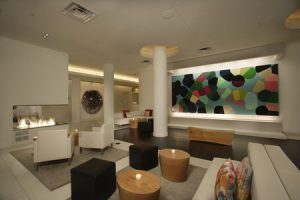Take two existing buildings, one an outdated hotel and the other a printing facility, and – using a collection of contemporary art – create a hotel that’s as much an art gallery as a hotel, both functionally and aesthetically.
You’ll have the Chambers Hotel in Minneapolis, completed just last year. The interior design was done by the Rockwell Group (New York), which had designed the Chambers Hotel in New York a few years ago. Both hotels involved owners who wanted their art collections to be central. But the difference, according to Gregory Stanford, a principal with Rockwell and a senior designer on the Minneapolis project, “was that from a design point of view, the New York hotel was more like a hotel as residence for an art collector. The Chambers in Minneapolis was more like a hotel as gallery, which shifted our emphasis on the decor.”
The shift in decor produced a stark minimalism. “Pretty much every wall surface in the hotel is gallery white,” Stanford says. “There’s a minimalist aesthetic that we applied to the whole place.” But what about the need for hotels to be warm and inviting? “We leaned toward the warm side of gray rather than the cool side with a lot of the surfaces we picked, like the dark wood floors and some of the area rugs and the bedding,” he says. Then there are the bathrooms, which provide a shock of bright color with a wall of glass tile, red in one building and blue in the other.
“At first there was some pushback about the white walls,” Stanford says, “but the artists are so amazing.” The focus is on contemporary Brits such as Damien Hirst, Rachel Whiteread and Tracy Emin. “We’ve never gotten an opportunity to use such a vast amount of art,” he says, “and once we saw the scale of it, we realized how important it was that the walls were white. Now, we wouldn’t have it any other way.”
Chambers Minneapolis is a relatively small hotel of only 60 rooms, all of them spacious, with high ceilings and large windows. In addition to original artwork in every room, the hotel displays sculptures in the courtyard and video art is present throughout the hotel, screening 24 hours a day in hallways and restrooms and on a courtyard wall.
It’s not only hotel guests who get to enjoy the artwork, however. With a fine restaurant, an outdoor area, meeting rooms and a top-floor lounge, there’s the capacity for a few hundred people. To get to the meeting rooms, visitors pass through what could easily be enjoyed as an art gallery.
Advertisement
While the two buildings have a similar façade and the same essential design characteristics, they’re each nonetheless unique. “The floor levels are different,” notes Stanford. “The ceilings are at different heights and the column structures aren’t the same. We created a bridge between the two buildings and we really had to think through the elevators and ramps and stairs.
“We stripped a lot of the architecture down to its basic elements,” he says. “The building that was originally a hotel had great architecture, not overly ornate. We uncovered beautiful stone walls on the lower level. The concrete columns holding up the lobby floor have tops that span out, which are really celebrated by the minimalist backgrounds.”
As an area with a thriving arts community, the Twin Cities seemed like just the right place for this hotel. The owner is involved with the Walker Art Center, and Rockwell hired the same lighting consultant who had done the lighting for the renowned Guthrie Theater. “It turns out that 20 of the Fortune 500 companies are headquartered in Minneapolis,” Stanford says, “so creative people from all over the world come here.”
It’s also a creative shift for the hospitality industry. “Generally, our clients in hospitality aren’t working in the minimalist aesthetic,” observes Stanford. “That’s just beginning to catch on now.”


 Photo Gallery3 days ago
Photo Gallery3 days ago
 Headlines1 week ago
Headlines1 week ago
 Sector Spotlight2 weeks ago
Sector Spotlight2 weeks ago
 Headlines1 week ago
Headlines1 week ago
 Headlines4 days ago
Headlines4 days ago
 Headlines2 weeks ago
Headlines2 weeks ago
 Designer Dozen1 week ago
Designer Dozen1 week ago
 Headlines2 days ago
Headlines2 days ago




















